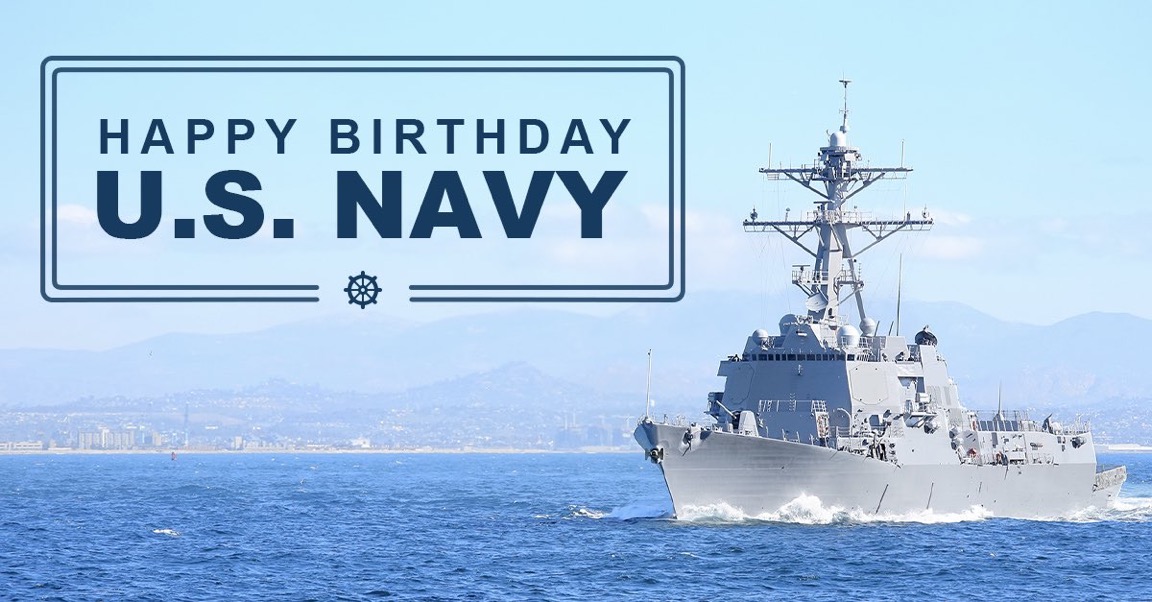Yesterday was the 248th birthday of the US Navy. As an all volunteer force it’s struggling to recruit enough sailors.

Despite a year of pilot programs aimed at getting new sailors, the Navy missed all its recruiting goals in Fiscal Year 2023, resulting in higher goals for next year, the sea service announced Tuesday.
The Navy missed its enlisted sailor goal by 7,464, according to the sea service’s numbers published Tuesday. It aimed to recruit 37,700 sailors, but ended the FY 2023 with 30,236. The service met its active-duty enlistment goal in Fiscal Year 2022 by a thin margin, USNI News previously reported.
The sea service fared no better with officers or reserve personnel. It missed the officer goal by 452, enlisted reserve goal by 2,048 and officer reserve by 773.
Despite the failure to meet its goals during the last fiscal year, the Navy has set higher goals for the FY 2024, likely to account for the lower recruiting year.
In FY 2024, the Navy aims to recruit 40,600 enlisted sailors, 2,807 active-duty officers, 7,629 enlisted reserve sailors and 1,785 reserve officers.
Although the Navy missed its recruiting goals, the service gained 6,000 more contracted future sailors in FY 2023 than it did in Fiscal Year 2022, Lt. Cmdr. Richard Parker told USNI News in an email.
“Looking back on FY23 Navy Recruiting Command is proud of the effort put forth not only by our hardworking and dedicated recruiters across the nation, but also by several new recruiting initiatives that have opened up opportunities for people to serve in the Navy. We are also proud of the fleet response to the recruiting shortage, and impressed by the ways the Navy has gone into action to help recruiting meet its goals,” Parker said in his email.
During FY 2023, the Navy introduced a number of policies and programs to address the decreasing pool of potential candidates, including increasing the age limit for enlistment and accepting sailors with lower scores on entrance exams.
“By carefully evaluating individual circumstances and granting waivers where appropriate, we have been able to tap into a broader talent pool, including individuals who may have previously been disqualified due to minor infractions or medical conditions. This flexibility has not only increased our recruitment numbers but also allowed us to consider candidates with unique skills and experiences that greatly benefit the Navy,” Capt. Jodie Cornell, spokesperson for the Office of the Chief of Navy Personnel, told USNI News in an email.
Navy Pilots and Policy Changes Over FY 2023
The Navy started FY 2023 by raising the maximum age for enlistment to 41, meaning anyone could enlist before their 42nd birthday, USNI News previously reported.
To raise the age, the Navy used a 16-year-old law previously used to help the Army raise its enlistment age, although the ground service has since lowered its maximum enlistment age.
A few days later, the Navy introduced its new ad campaign, using social media to target the Gen-Z population. The “Forged By The Sea” videos included sailors describing why they joined the Navy and the opportunities presented by service.
In December, the Navy announced it would accept recruits with lower scores on the Armed Forces Qualification Test, USNI News reported at the time. Under the pilot program, the sea service would take up to 20 percent of recruits who scored between 10-30 on the test, which would put them in Category 4, as long as they scored high enough on the Armed Services Vocational Aptitude Battery to qualify for a Navy rating.
The Amed Forces Qualification Test works more like the Graduate Record Examinations test, in which each test taker is scored against each other, resulting in percentiles for the scores, Navy Recruiting Command told USNI News at the time. The change put more weight on the ASVAB, which the Navy considered to be a better assessment of recruits.
In February, the Navy bought ad space in specific markets during the Super Bowl to release “Forged By The Sea” videos. It cost the Navy $1.8 million and marked a change in recruiting tactics, as the Navy had previously stopped airing television ads.
A month later, the sea service introduced a new program aimed at those who had not met the body composition requirements for joining the Navy. Potential recruits would go through a three-week program at Great Lakes, Ill., where Navy leaders and sailors would help them with fitness in order to meet the requirements. At the end of the three weeks, they would get reevaluated to see if they could transition to boot camp.
The sea service also offered a variety of enlisted shipping bonuses and extended waivers, Cornell said. This included expanding waiver authority for positive drug or alcohol tests, tattoos and age, and starting a pilot for single parents that waived dependency status. Under the single-parent program, sailors can enlist if they are a single parent, as long as they do not have two dependents under 18 or children under one year old.
The service will continue with its “Every Sailor is a Recruiter” program, with incentives added in FY 2023, Cornell said. The program generated 800 leads, as of August, which resulted in 150 contracts.
Many of the programs and pilots will continue in Fiscal Year 2024, Parker said. It’s too early for the Navy to assess many of the programs introduced in the last fiscal year.
“Recruiting will continue to think outside of the box and look for opportunities that increase exposure to our target audience and that increase opportunities for that audience to join the Navy. Anything that helps us do that is a success,” Parker said in his email.
One effort that did not work was the introduction of a six-day work week for recruiters, an effort that lasted two days before getting recalled. The announcement that recruiters would have to work an additional day per work week faced backlash from the naval community, USNI News previously reported.
Retention
While the Navy struggled to recruit, it also tried to increase retention to better meet the fleet’s manning requirements.
The Navy surpassed its retention goals for all but one category, Cornell said in her email. The Navy retained 19,386 sailors in Zone A, which are sailors with up to six years of service, meeting 114.3 percent of the goal.
The Navy narrowly missed its goal in Zone B – sailors with six to 10 years of service – with 7,285 sailors retained, 98.2 percent of the goal. For Zone C – sailors with 10 to 14 years of service – the Navy retained 5,462 or 106.5 percent of its goal.
One of the biggest initiatives in retaining more sailors was the change to billet-based advancements, which is expected to be the Navy standard, Cornell said. The senior enlisted marketplace, which has been introduced through pilots for specific billets, is meant to give sailors more control over their promotions and positions, USNI News previously reported.
Over FY 2023, the Navy also used expanded selective reenlistment bonuses and suspended high-year tenure as way to increase the number of sailors who reenlisted, Cornell said.
© 2012-2023 U.S. NAVAL INSTITUTE Original here.
